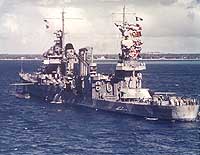
USS Quincy, a 9375-ton New Orleans class heavy cruiser, was built at Quincy, Massachusetts. Commissioned in June 1936, she soon was sent to the western Mediterranean Sea for three months to protect American interests during the Spanish Civil War. In April 1937, Quincy passed through the Panama Canal to begin operations in the Pacific. She returned to the Atlantic in January 1939 and in February took part in Fleet Problem XX in the Caribbean. A good will cruise in South American waters followed in April-June 1939.
With the outbreak of World War II in Europe in early September 1939, Quincy began Neutrality Patrol activities in the western Atlantic area. She revisited South America during mid-1940 and over the next year participated in Naval Reserve training voyages, more Neutrality enforcement patrols and Caribbean amphibous warfare exercises. Beginning in July 1941, the Quincy cruised between the Atlantic coast and Iceland, marking an extension of U.S. "short of war" operations to the middle of the North Atlantic. Later in the year, she escorted a convoy from South Africa to Trinadad. These escort and patrol duties continued after the United States entered the war in December 1941.
Following an overhaul, Quincy transferred to the Pacific Fleet in June 1942. The next month, she was sent to New Zealand, where she joined the forces preparing for the invasion of the southern Solomon Islands. On 7 August 1942, Quincy bombarded Japanese installations on Guadalcanal in support of the U.S. Marine Corps landing there. During the night of 8-9 August, she was one of three heavy cruisers stationed in the northern approaches to the invasion zone and was sunk there by a force of Japanese cruisers in the disastrous Battle of Savo Island in the early morning darkness of 9 August 1942.
Fifty years later, in August 1992, Quincy's wreck was located and examined on the sea floor of what had come to be called "Iron Bottom Sound". She lies upright in some 3000 feet of water, with her bow broken off immediately in front of her forward eight-inch gun turrets, both of which are trained out to starboard. The ship's shell-riddled forward superstructure, shattered left gun of Turret # 2, destroyed aircraft hangar and collapsed after deck are indications of the battering she received from Japanese weapons during her final moments on the surface and from the crushing force of the deep sea after she sank.
This page features selected views of USS Quincy (CA-39).
For pictorial coverage of Quincy's last Commanding
Officer, see:
| If you want higher resolution reproductions than the digital images presented here, see: "How to Obtain Photographic Reproductions." |
Click on the small photograph to prompt a larger view of the same image.
|
Photo #: NH 42259 USS Quincy (CA-39) Photographed during the later 1930s. U.S. Naval Historical Center Photograph. Online Image: 86KB; 740 x 530 pixels |
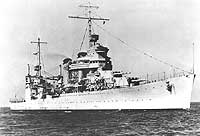 |
|
Photo #: NH 50314 USS Quincy (CA-39) Underway at sea, circa 1937. U.S. Naval Historical Center Photograph. Online Image: 78KB; 740 x 590 pixels |
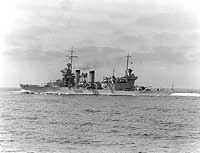 |
|
Photo #: NH 97697 USS Quincy (CA-39) Underway on 1 May 1940, as seen from a Utility Squadron One aircraft. Note identification markings on her turret tops: longitudinal stripes on the forward turrets and a circle on the after one. Official U.S. Navy Photograph, from the collections of the Naval Historical Center. Online Image: 99KB; 740 x 605 pixels |
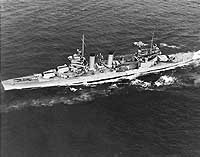 |
|
Photo #: 19-N-30732 USS Quincy (CA-39) In New York Harbor, 23 May 1942, following her last overhaul. In the left background is HMS Biter (British Escort Aircraft Carrier, 1942). Note Quincy's Measure 12, Modified, camouflage scheme. Photograph from the Bureau of Ships Collection in the U.S. National Archives. Online Image: 100KB; 740 x 615 pixels Reproductions of this image may also be available through the National Archives photographic reproduction system. |
 |
|
Photo #: 19-N-30731 USS Quincy (CA-39) In New York Harbor, 23 May 1942, after her last overhaul. HMS Biter (British Escort Aircraft Carrier, 1942) is in the left background, partially hidden by Quincy's bow. Photograph from the Bureau of Ships Collection in the U.S. National Archives. Online Image: 79KB; 740 x 615 pixels Reproductions of this image may also be available through the National Archives photographic reproduction system. |
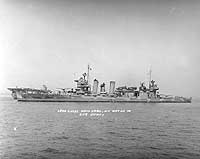 |
|
Photo #: 80-G-K-563 (Color) USS Quincy (CA-39) Photographed from USS Wasp (CV-7), at Noumea, New Caledonia, on the eve of the invasion of Guadalcanal, 3 August 1942. She was sunk six days later, during the Battle of Savo Island. Note Quincy's signal flags and Measure 12, Modified, camouflage scheme. Official U.S. Navy Photograph, now in the collections of the U.S. National Archives. Online Image: 97KB; 740 x 600 pixels Reproductions of this image may also be available through the National Archives photographic reproduction system. |
 |
|
Photo #: NH 83591 Cruiser Division Seven's South American Cruise, 1939 View of USS Quincy (CA-39)--at left--and USS Tuscaloosa (CA-37) steaming in rough seas near the Strait of Magellan, 14 May 1939. Courtesy of the Naval Historical Foundation. Collection of Rear Admiral Paul H. Bastedo. U.S. Naval Historical Center Photograph. Online Image: 106KB; 740 x 605 pixels |
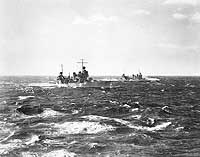 |
|
Photo #: NH 83592 USS Quincy (CA-39) View looking forward from her bridge, while she was steaming through rough seas in the Strait of Magellan during Cruiser Division Seven's South American Cruise, 14 May 1939. Courtesy of the Naval Historical Foundation. Collection of Rear Admiral Paul H. Bastedo. U.S. Naval Historical Center Photograph. Online Image: 86KB; 740 x 610 pixels |
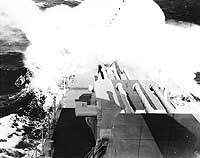 |
|
Photo #: 19-N-30726 USS Quincy (CA-39) View on board, looking aft on the port side from alongside eight-inch gun turret # 1, while the ship was at the New York Navy Yard on 29 May 1942. Numbers in white circles mark recently installed items, including (# 1) splinter protection on the pilothouse; (# 2) 20mm guns just forward of the pilothouse (largely hidden behind the second 8" gun turret); and (# 3) 1.1" gun mountings on the upper bridge wings. Other notable items include paravanes on the superstructure side just forward of the second 8" gun turret and the rangefinder "tub" atop the pilothouse. Many of these features were still present when the ship's wreck was examined in August 1992. Photograph from the Bureau of Ships Collection in the U.S. National Archives. Online Image: 108KB; 740 x 625 pixels Reproductions of this image may also be available through the National Archives photographic reproduction system. |
 |
|
Photo #: 19-N-30725 USS Quincy (CA-39) View on board, looking forward over the boat deck from the secondary conn, while the ship was at the New York Navy Yard after her last overhaul, 29 May 1942. Crude # "1" in white circle (center) marks the location of the 5"/25 loading practice machine. Other notable items include: boats and boat cradle in foreground; four Curtiss SOC "Seagull" floatplanes atop the catapults; crated food piled by the after smokestack; and USS Marblehead (CL-12) at left. Photograph from the Bureau of Ships Collection in the U.S. National Archives. Online Image: 156KB; 740 x 615 pixels Reproductions of this image may also be available through the National Archives photographic reproduction system. |
 |
|
Photo #: 80-G-K-554 (Color) USS President Adams (AP-38) Photographed from USS Wasp (CV-7), at Noumea, New Caledonia, 4 August 1942. She is crowded with U.S. Marines, bound for the invasion of Guadalcanal. USS Quincy (CA-39) is in the background. Note President Adams' liferafts, landing craft and climbing netting. Official U.S. Navy Photograph, now in the collections of the U.S. National Archives. Online Image: 93KB; 740 x 610 pixels Reproductions of this image may also be available through the National Archives photographic reproduction system. |
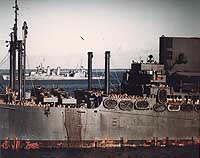 |
|
Photo #: NH 50346 USS Quincy (CA-39) Photographed from a Japanese cruiser during the Battle of Savo Island, off Guadalcanal, 9 August 1942. Quincy, seen here burning and illuminated by Japanese searchlights, was sunk in this action. Copied from the Rear Admiral Samuel Eliot Morison World War II history illustrations file. U.S. Naval Historical Center Photograph. Online Image: 54KB; 740 x 555 pixels |
 |
For pictorial coverage of Quincy's last Commanding
Officer, see:
| If you want higher resolution reproductions than the digital images presented here, see: "How to Obtain Photographic Reproductions." |
Page made 29 September 1998
Link added 24 November 2001